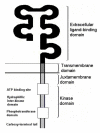Evaluation of the kinase domain of c-KIT in canine cutaneous mast cell tumors
- PMID: 16579858
- PMCID: PMC1448201
- DOI: 10.1186/1471-2407-6-85
Evaluation of the kinase domain of c-KIT in canine cutaneous mast cell tumors
Abstract
Background: Mutations in the c-KIT proto-oncogene have been implicated in the progression of several neoplastic diseases, including gastrointestinal stromal tumors and mastocytosis in humans, and cutaneous mast cell tumors (MCTs) in canines. Mutations in human mastocytosis patients primarily occur in c-KIT exon 17, which encodes a portion of its kinase domain. In contrast, deletions and internal tandem duplication (ITD) mutations are found in the juxtamembrane domain of c-KIT in approximately 15% of canine MCTs. In addition, ITD c-KIT mutations are significantly associated with aberrant KIT protein localization in canine MCTs. However, some canine MCTs have aberrant KIT localization but lack ITD c-KIT mutations, suggesting that other mutations or other factors may be responsible for aberrant KIT localization in these tumors.
Methods: In order to characterize the prevalence of mutations in the phospho-transferase portion of c-KIT's kinase domain in canine MCTs exons 16-20 of 33 canine MCTs from 33 dogs were amplified and sequenced. Additionally, in order to determine if mutations in c-KIT exon 17 are responsible for aberrant KIT localization in MCTs that lack juxtamembrane domain c-KIT mutations, c-KIT exon 17 was amplified and sequenced from 18 canine MCTs that showed an aberrant KIT localization pattern but did not have ITD c-KIT mutations.
Results: No mutations or polymorphisms were identified in exons 16-20 of any of the MCTs examined.
Conclusion: In conclusion, mutations in the phospho-transferase portion of c-KIT's kinase domain do not play an important role in the progression of canine cutaneous MCTs, or in the aberrant localization of KIT in canine MCTs.
Figures




References
-
- Yarden Y, Escobedo JA, Kuang WJ, Yang-Feng TL, Daniel TO, Tremble PM, Chen EY, Ando ME, Harkins RN, Francke U, Fried VA, Ullrich A, Williams LT. Structure of the receptor for platelet-derived growth factor helps define a family of closely related growth factor receptors. Nature. 1986;323:226–232. doi: 10.1038/323226a0. - DOI - PubMed
-
- Nocka K, Majumder S, Chabot B, Ray P, Cervone M, Bernstein A, Besmer P. Expression of c-kit gene products in known cellular targets of W mutations in normal and W mutant mice- evidence for an impaired c-kit kinase in mutant mice. Genes Dev. 1989;3:816–826. - PubMed
-
- Natali PG, Nicotra MR, Sures I, Santoro E, Bigotti A, Ullrich A. Expression of c-kit receptor in normal and transformed human nonlymphoid tissues. Cancer Res. 1992;53:6139–6143. - PubMed
Publication types
MeSH terms
Substances
Grants and funding
LinkOut - more resources
Full Text Sources
Medical

